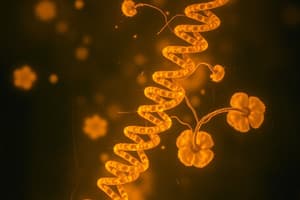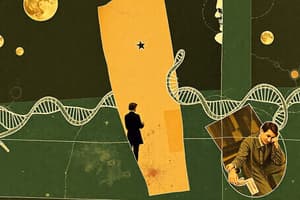Podcast
Questions and Answers
What is an operon?
What is an operon?
- A type of protein
- A regulatory gene
- A mutation type
- A gene cluster controlled by a single promoter (correct)
Is the operon described inducible or repressible?
Is the operon described inducible or repressible?
Repressible
What effect will a mutation at the operator site have on a repressible operon?
What effect will a mutation at the operator site have on a repressible operon?
The operon will always be transcriptionally active.
Where might a mutation occur in a mutant strain of E. coli that produces β-galactosidase in the presence and absence of lactose?
Where might a mutation occur in a mutant strain of E. coli that produces β-galactosidase in the presence and absence of lactose?
What is the function of the promoter in the E. coli lac operon?
What is the function of the promoter in the E. coli lac operon?
What does the repressor do in the E. coli lac operon?
What does the repressor do in the E. coli lac operon?
Place the events of gene regulation by the lac operon in order from the introduction of lactose to when the cell begins to digest lactose:
Place the events of gene regulation by the lac operon in order from the introduction of lactose to when the cell begins to digest lactose:
Is the lac operon inducible or repressible?
Is the lac operon inducible or repressible?
What happens to the trp operon when levels of tryptophan in the cell are low?
What happens to the trp operon when levels of tryptophan in the cell are low?
Transcription occurs in the nucleus in eukaryotic gene regulation.
Transcription occurs in the nucleus in eukaryotic gene regulation.
What are CpG islands?
What are CpG islands?
What is a missense mutation?
What is a missense mutation?
What environmental agent significantly increases mutation rates?
What environmental agent significantly increases mutation rates?
Which choice is not a mechanism of gene regulation after transcription in eukaryotes?
Which choice is not a mechanism of gene regulation after transcription in eukaryotes?
Flashcards are hidden until you start studying
Study Notes
Gene Regulation in Operons
- Operon: A cluster of genes regulated by a single promoter, producing one mRNA strand.
- Repressible Operon: Transcription is normally active but stops in response to a specific molecule, e.g., compound B inhibits transcription when present.
- Inducible Operon: Transcription is off until activated by a specific molecule, such as lactose in the lac operon.
Lac Operon Specifics
- Lac Repressor: Binds to the lac operator and inhibits transcription when lactose is absent.
- Regulatory Mechanism: Allolactose, formed from lactose, binds to the repressor, inactivating it and allowing transcription.
- Transcription Steps: Introduction of lactose → Repressor inactivated → RNA polymerase binds leading to lactose gene expression → Digestion of lactose begins.
Tryptophan Operon Context
- trp Operon Repression: Active when tryptophan levels are low. When levels rise, tryptophan binds to the repressor, leading to transcription termination.
- Transcription Regulation Steps: Low tryptophan → RNA polymerase binds → Tryptophan synthesized → High levels induce repressor binding → Transcription stops.
Comparative Gene Regulation
- Prokaryotic vs. Eukaryotic:
- Prokaryotic: Operons, no introns, simultaneous transcription/translation in cytoplasm.
- Eukaryotic: Genes on different chromosomes, mRNA modified (5' cap, poly-A tail), transcription in nucleus, translation in cytoplasm.
Post-Transcriptional Control
- Alternative RNA Splicing: Allows production of multiple proteins from a single gene.
- MicroRNA (miRNA): Binds to mRNA, preventing translation and regulating gene expression.
- Epigenetic Regulation: Heritable gene expression changes without DNA sequence alteration, e.g., via chromatin modification.
Mutation Types
- Substitution Mutation: Replacement of one nucleotide with another, leading to potential amino acid changes (missense mutation).
- Frameshift Mutation: Caused by insertion or deletion of nucleotides, shifting reading frame.
- Somatic vs. Germ-Line Mutations: Somatic affects the individual; germ-line can be inherited.
Environmental Impacts on DNA
- Mutagen: Environmental agents that significantly increase mutation rates.
- UV Light Effects: Can cause pyrimidine dimers in DNA, leading to errors in DNA replication.
Structure & Functionality
- Basal Transcription Apparatus: A complex of RNA polymerase and associated proteins that initiates transcription.
- CpG Islands: Regions in DNA with high cytosine-guanine content, often involved in gene regulation.
Special Cases in Gene Expression
- Regulatory Genes: Produce products that influence transcription and translation of other genes.
- Operator Role: Site where repressor proteins bind to inhibit transcription.
- Catabolite Repression: Mechanism in which glucose availability influences the metabolism of alternative sugars.
Phenotypic Expression Examples
- Epigenetics in Tortoiseshell Cats: X-linked alleles expressed variably in cells due to chromatin modifications, producing a patchy color pattern.
Summary of Key Mechanisms
- Transcription Factors: Influence RNA polymerase activity by binding to DNA.
- Protein Modifications: Post-translational changes can include phosphorylation and methylation, impacting protein function and stability.
Overall Implications
- Different cell types express specific genes at varying levels, despite identical genetic information across cells.
- Understanding operons and gene regulation mechanisms is crucial in fields like biotechnology and medicine.
Studying That Suits You
Use AI to generate personalized quizzes and flashcards to suit your learning preferences.




